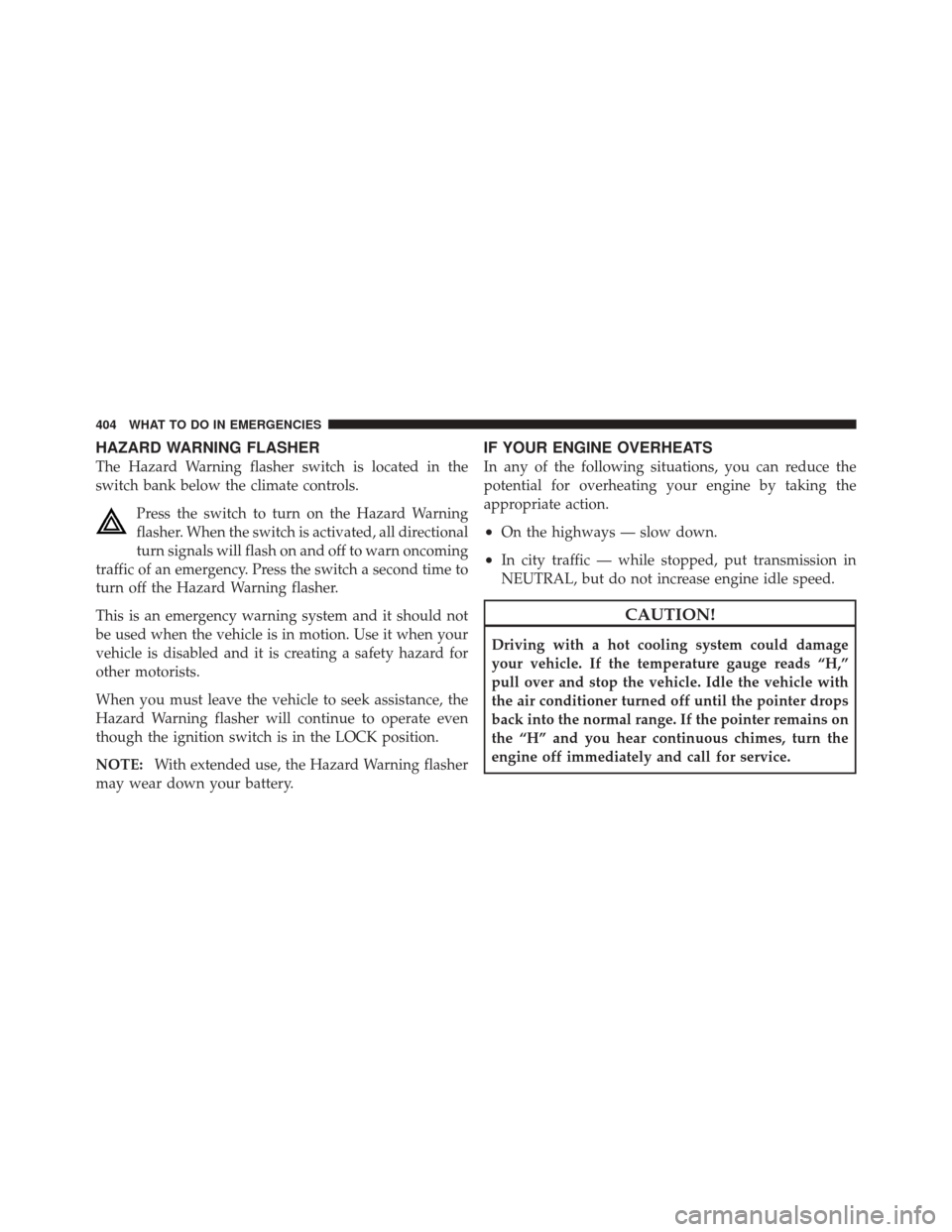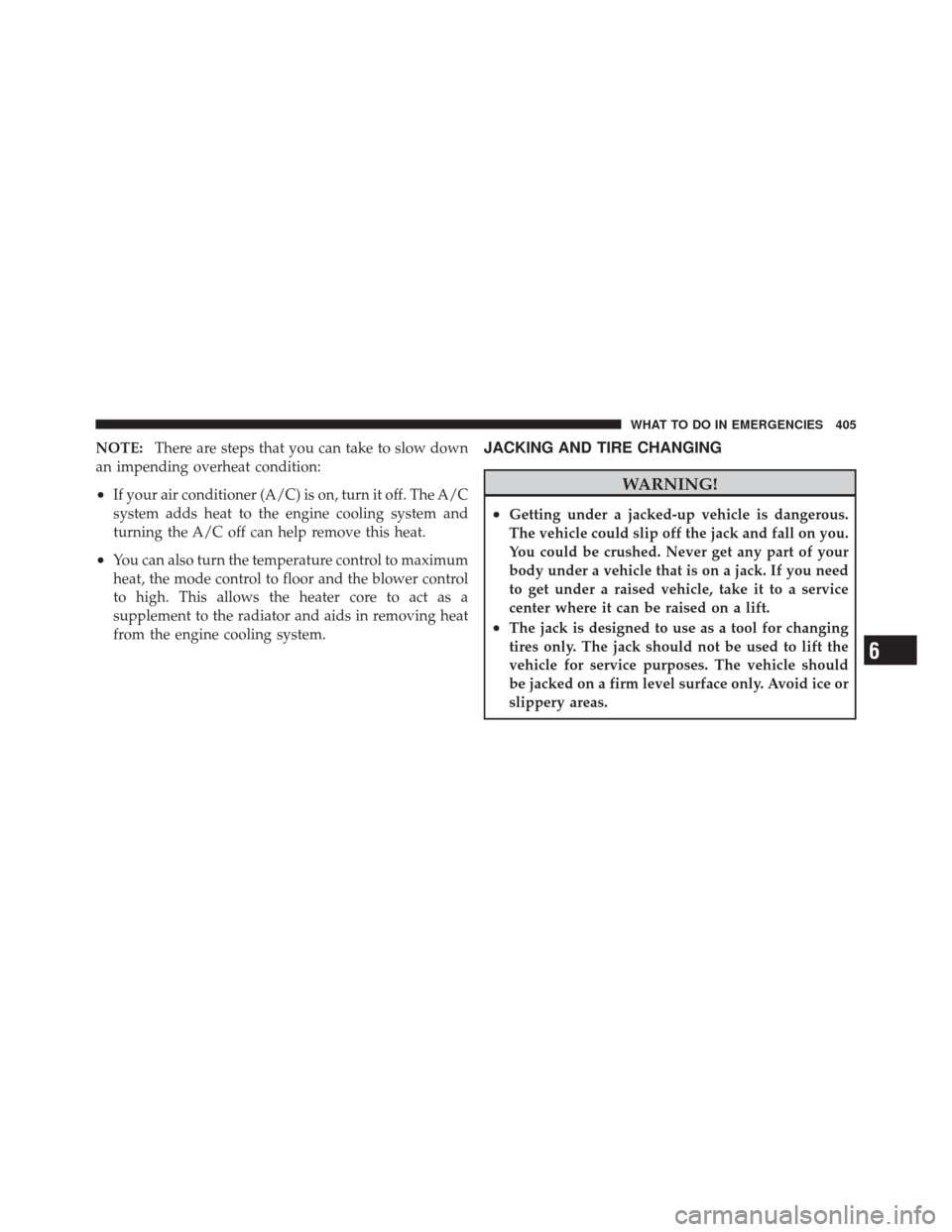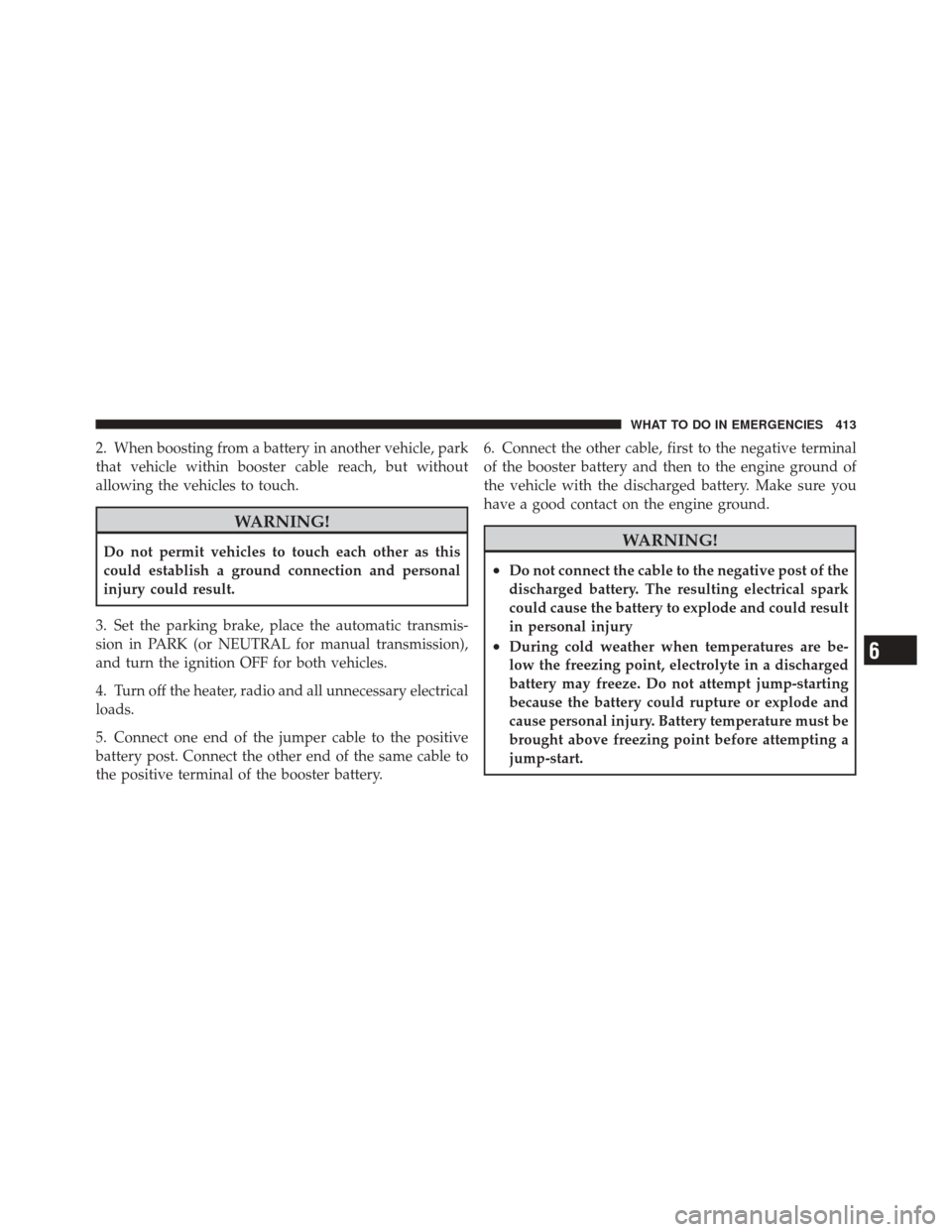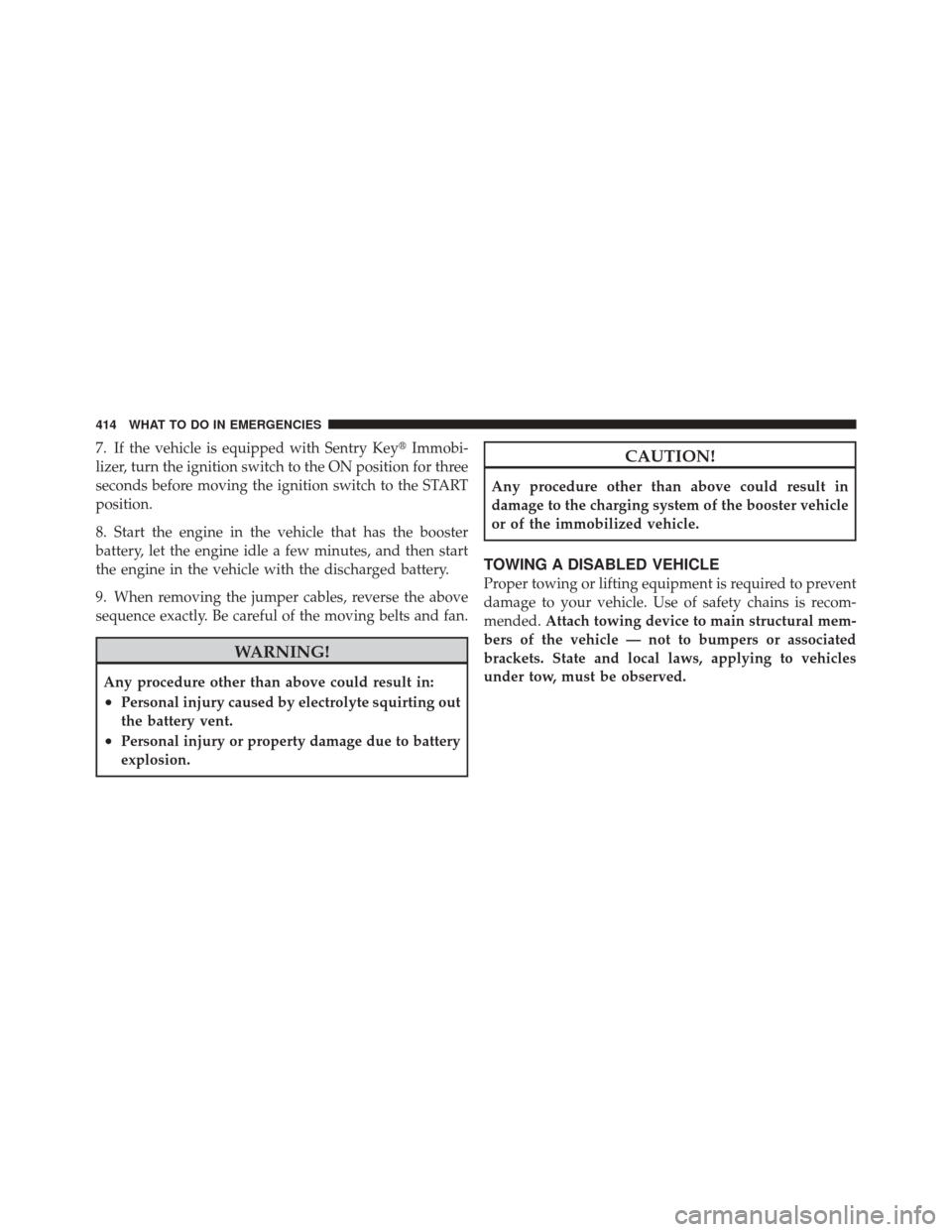Page 401 of 522

CAUTION!
Damage to the transmission may occur if the trans-
mission is shifted into PARK with the transfer case in
NEUTRAL and the engine RUNNING. With the
transfer case in NEUTRAL, ensure that the engine is
OFF prior to shifting the transmission into PARK.
Shifting Out of NEUTRAL
Perform the following procedure to prepare your vehicle
for normal usage:
1. Bring the vehicle to a complete stop.
2. Reconnect the negative battery cable.
3. Place the ignition switch in the LOCK position (if it
has been moved or the engine has been started).
4. Turn the ignition switch to the ON position, but do not
start the engine.5. Press the brake pedal.
6. Shift the transmission into NEUTRAL.
7. Use the point of a ballpoint pen or similar object to
press the recessed transfer case NEUTRAL button. Re-
lease the NEUTRAL button after the NEUTRAL indicator
light turns off (approximately one second). After the
NEUTRAL button is released, the transfer case will shift
to the position identified by the selector switch.
8. Start the engine.
9. Shift the transmission into DRIVE.
10. Set the parking brake.
11. Shift the transmission into PARK.
400 STARTING AND OPERATING
Page 404 of 522
WHAT TO DO IN EMERGENCIES
CONTENTS
�Hazard Warning Flasher ................ 404
� If Your Engine Overheats ................ 404
� Jacking And Tire Changing ............... 405
▫ Jack Location ....................... 406
▫ Spare Tire Stowage ................... 406 ▫
Spare Tire Removal ................... 406
▫ Preparations For Jacking ............... 407
▫ Jacking Instructions ................... 408
� Jump-Starting ........................ 412
� Towing A Disabled Vehicle ............... 414
6
Page 405 of 522

HAZARD WARNING FLASHER
The Hazard Warning flasher switch is located in the
switch bank below the climate controls.Press the switch to turn on the Hazard Warning
flasher. When the switch is activated, all directional
turn signals will flash on and off to warn oncoming
traffic of an emergency. Press the switch a second time to
turn off the Hazard Warning flasher.
This is an emergency warning system and it should not
be used when the vehicle is in motion. Use it when your
vehicle is disabled and it is creating a safety hazard for
other motorists.
When you must leave the vehicle to seek assistance, the
Hazard Warning flasher will continue to operate even
though the ignition switch is in the LOCK position.
NOTE: With extended use, the Hazard Warning flasher
may wear down your battery.
IF YOUR ENGINE OVERHEATS
In any of the following situations, you can reduce the
potential for overheating your engine by taking the
appropriate action.
•On the highways — slow down.
•In city traffic — while stopped, put transmission in
NEUTRAL, but do not increase engine idle speed.
CAUTION!
Driving with a hot cooling system could damage
your vehicle. If the temperature gauge reads “H,”
pull over and stop the vehicle. Idle the vehicle with
the air conditioner turned off until the pointer drops
back into the normal range. If the pointer remains on
the “H” and you hear continuous chimes, turn the
engine off immediately and call for service.
404 WHAT TO DO IN EMERGENCIES
Page 406 of 522

NOTE:There are steps that you can take to slow down
an impending overheat condition:
•If your air conditioner (A/C) is on, turn it off. The A/C
system adds heat to the engine cooling system and
turning the A/C off can help remove this heat.
•You can also turn the temperature control to maximum
heat, the mode control to floor and the blower control
to high. This allows the heater core to act as a
supplement to the radiator and aids in removing heat
from the engine cooling system.
JACKING AND TIRE CHANGING
WARNING!
•Getting under a jacked-up vehicle is dangerous.
The vehicle could slip off the jack and fall on you.
You could be crushed. Never get any part of your
body under a vehicle that is on a jack. If you need
to get under a raised vehicle, take it to a service
center where it can be raised on a lift.
•The jack is designed to use as a tool for changing
tires only. The jack should not be used to lift the
vehicle for service purposes. The vehicle should
be jacked on a firm level surface only. Avoid ice or
slippery areas.
6
WHAT TO DO IN EMERGENCIES 405
Page 409 of 522

5. Turn on the Hazard Warning flasher.6. Block both the front and rear of the
wheel diagonally opposite of the jack-
ing position. For example, if changing
the right front tire, block the left rear
wheel.
NOTE: Passengers should not remain in the vehicle
when the vehicle is being jacked.
Jacking Instructions
WARNING!
Carefully follow these tire changing warnings to
help prevent personal injury or damage to your
vehicle:
(Continued)
WARNING! (Continued)
•Always park on a firm, level surface as far from
the edge of the roadway as possible before raising
the vehicle.
•Block the wheel diagonally opposite the wheel to
be raised.
•Set the parking brake firmly and set an automatic
transmission in PARK; a manual transmission in
REVERSE.
•Never start or run the engine with the vehicle on a
jack.
•Do not let anyone sit in the vehicle when it is on a
jack.
•Do not get under the vehicle when it is on a jack.
•Only use the jack in the positions indicated and
for lifting this vehicle during a tire change.(Continued)
408 WHAT TO DO IN EMERGENCIES
Page 414 of 522

2. When boosting from a battery in another vehicle, park
that vehicle within booster cable reach, but without
allowing the vehicles to touch.
WARNING!
Do not permit vehicles to touch each other as this
could establish a ground connection and personal
injury could result.
3. Set the parking brake, place the automatic transmis-
sion in PARK (or NEUTRAL for manual transmission),
and turn the ignition OFF for both vehicles.
4. Turn off the heater, radio and all unnecessary electrical
loads.
5. Connect one end of the jumper cable to the positive
battery post. Connect the other end of the same cable to
the positive terminal of the booster battery. 6. Connect the other cable, first to the negative terminal
of the booster battery and then to the engine ground of
the vehicle with the discharged battery. Make sure you
have a good contact on the engine ground.WARNING!
•Do not connect the cable to the negative post of the
discharged battery. The resulting electrical spark
could cause the battery to explode and could result
in personal injury
•During cold weather when temperatures are be-
low the freezing point, electrolyte in a discharged
battery may freeze. Do not attempt jump-starting
because the battery could rupture or explode and
cause personal injury. Battery temperature must be
brought above freezing point before attempting a
jump-start.6
WHAT TO DO IN EMERGENCIES 413
Page 415 of 522

7. If the vehicle is equipped with Sentry Key�Immobi-
lizer, turn the ignition switch to the ON position for three
seconds before moving the ignition switch to the START
position.
8. Start the engine in the vehicle that has the booster
battery, let the engine idle a few minutes, and then start
the engine in the vehicle with the discharged battery.
9. When removing the jumper cables, reverse the above
sequence exactly. Be careful of the moving belts and fan.
WARNING!
Any procedure other than above could result in:
•Personal injury caused by electrolyte squirting out
the battery vent.
•Personal injury or property damage due to battery
explosion.
CAUTION!
Any procedure other than above could result in
damage to the charging system of the booster vehicle
or of the immobilized vehicle.
TOWING A DISABLED VEHICLE
Proper towing or lifting equipment is required to prevent
damage to your vehicle. Use of safety chains is recom-
mended. Attach towing device to main structural mem-
bers of the vehicle — not to bumpers or associated
brackets. State and local laws, applying to vehicles
under tow, must be observed.
414 WHAT TO DO IN EMERGENCIES
Page 418 of 522
MAINTAINING YOUR VEHICLE
CONTENTS
�Engine Compartment — 3.7L ............. 419
� Onboard Diagnostic System — OBD II ...... 420
▫ Loose Fuel Filler Cap Message ........... 420
� Emissions Inspection And Maintenance
Programs ............................ 421
� Replacement Parts ..................... 422
� Dealer Service ........................ 423
� Maintenance Procedures ................. 423
▫ Engine Oil ......................... 424 ▫
Engine Oil Filter ..................... 427
▫ Engine Air Cleaner Filter ............... 427
▫ Maintenance-Free Battery .............. 428
▫ Air Conditioner Maintenance ............ 429
▫ A/C Air Filter — If Equipped ........... 430
▫ Body Lubrication .................... 431
▫ Windshield Wiper Blades ............... 431
▫ Adding Washer Fluid ................. 432
▫ Exhaust System ..................... 433
7